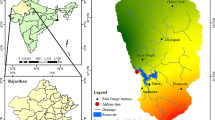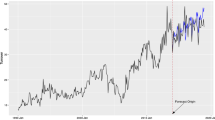Abstract
Seasonal autoregressive integrated moving average (SARIMA) models form one of the most popular and widely used seasonal time series models over the past three decades. However, in several researches it has been argued that they have two basic limitations that detract from their popularity for seasonal time series forecasting tasks. SARIMA models assume that future values of a time series have a linear relationship with current and past values as well as with white noise; therefore, approximations by SARIMA models may not be adequate for complex nonlinear problems. In addition, SARIMA models require a large amount of historical data to produce desired results. However, in real situations, due to uncertainty resulting from the integral environment and rapid development of new technology, future situations must be forecasted using small data sets over a short span of time. Using hybrid models or combining several models has become a common practice to overcome the limitations of single models and improve forecasting accuracy. In this paper, a new hybrid model, which combines the seasonal autoregressive integrated moving average (SARIMA) and computational intelligence techniques such as artificial neural networks and fuzzy models for seasonal time series forecasting is proposed. In the proposed model, these two techniques are applied to simultaneously overcome the linear and data limitations of SARIMA models and yield more accurate results. Empirical results of forecasting two well-known seasonal time series data sets indicate that the proposed model exhibits effectively improved forecasting accuracy, so that it can be used as an appropriate seasonal time series model.







Similar content being viewed by others
References
Bates JM, Granger WJ (1969) The combination of forecasts. Oper Res 20:451–468
Benardos PG, Vosniakos GC (2002) Prediction of surface roughness in CNC face milling using neural networks and Taguchi’s design of experiments. Robot Comput Integr Manuf 18:343–354
Benardos PG, Vosniakos GC (2007) Optimizing feed-forward artificial neural network architecture. Eng Appl Artif Intell 20:365–382
Box P, Jenkins GM (1976) Time series analysis: forecasting and control. Holden-day Inc, San Francisco
Chen K, Wang C (2007) A hybrid SARIMA and support vector machines in forecasting the production values of the machinery industry in Taiwan. Expert Syst Appl 32:254–264
Chen A, Leung MT, Hazem D (2003) Application of neural networks to an emerging financial market: forecasting and trading the Taiwan Stock Index. Comput Oper Res 30:901–923
Cheng C, Cheng G, Wang J (2008) Multi-attribute fuzzy time series method based on fuzzy clustering. Expert Syst Appl 34:1235–1242
Clemen R (1989) Combining forecasts: a review and annotated bibliography with discussion. Int J Forecast 5:559–608
Dubois D, Prade H (1980) Theory and applications’, fuzzy sets and systems. Academic Press, New York
Egrioglu E, Aladag CH, Yolcu U, Basaran MA, Uslu VR (2009) A new hybrid approach based on SARIMA and partial high order bivariate fuzzy time series forecasting model. Expert Syst Appl 36:7424–7434
Hamzaçebi C (2008) Improving artificial neural networks’ performance in seasonal time series forecasting. Inf Sci 178:4550–4559
Haseyama M, Kitajima H (2001) An ARMA order selection method with fuzzy reasoning. Signal Process 81:1331–1335
Hosseini H, Luo D, Reynolds KJ (2006) The comparison of different feed forward neural network architectures for ECG signal diagnosis. Med Eng Phys 28:372–378
Hurvich CM, Tsai CL (1989) Regression and time series model selection in small samples. Biometrica 76(2):297–307
Hwang HB (2001) Insights into neural-network forecasting time series corresponding to ARMA (p; q) structures. Omega 29:273–289
Ishibuchi H, Tanaka H (1988) Interval regression analysis based on mixed 0–1 integer programming problem. J Jpn Soc Ind Eng 40(5):312–319
Jiang X, Wah AHKS (2003) Constructing and training feed-forward neural networks for pattern classification. Pattern Recogn 36:853–867
Jones RH (1975) Fitting autoregressions. J Am Stat Assoc 70(351):590–592
Khashei M (2005) Forecasting the Isfahan steel company production price in Tehran metals exchange using artificial neural networks (ANNs). Master of Science Thesis, Isfahan University of Technology
Khashei M, Bijari M (2010) An artificial neural network (p, d, q) model for time series forecasting. Expert Syst Appl 37:479–489
Khashei M, Bijari M (2011) A novel hybridization of artificial neural networks and ARIMA models for time series forecasting. Appl Soft Comput 11:2664–2675
Khashei M, Hejazi SR, Bijari M (2008) A new hybrid artificial neural networks and fuzzy regression model for time series forecasting. Fuzzy Sets Syst 159:769–786
Khashei M, Bijari M, Raissi GHA (2009) Improvement of auto-regressive integrated moving average models using fuzzy logic and artificial neural networks (ANNs). Neurocomputing 72:956–967
Lee J, Kang S (2007) GA based meta-modeling of BPN architecture for constrained approximate optimization. Int J Solids Struct 44:5980–5993
Leski J, Czogala E (1999) A new artificial network based fuzzy interference system with moving consequents in if–then rules and selected applications. Fuzzy Sets Syst 108:289–297
Lisi F, Schiavo RA (1999) A comparison between neural networks and chaotic models for exchange rate prediction. Comput Stat Data Anal 30:87–102
Ljung L (1987) System identification theory for the user. Prentice-Hall, Englewood Cliffs
Ma L, Khorasani K (2003) A new strategy for adaptively constructing multilayer feed-forward neural networks. Neurocomputing 51:361–385
Marin D, Varo A, Guerrero JE (2007) Non-linear regression methods in NIRS quantitative analysis. Talanta 72:28–42
Minerva T, Poli I (2001) Building ARMA models with genetic algorithms. Lecture Notes Comput Sci 2037:335–342
Montgomery DC, Johnson LA, Gardiner JS (1990) Forecasting and time series analysis. McGraw-Hill, New York
Morgan N, Bourlard H (1990) Generalization and parameter estimation in feedforward nets: some experiments, In: Touretzky DS (ed) Advances in neural information processing systems, vol 2, pp 630–637
Ong CS, Huang JJ, Tzeng GH (2005) Model identification of ARIMA family using genetic algorithms. Appl Math Comput 164(3):885–912
Pai PF, Lin CS (2005) A hybrid ARIMA and support vector machines model in stock price forecasting. Omega 33:497–505
Reid MJ (1968) Combining three estimates of gross domestic product. Economica 35:431–444
Ross JP (1996) Taguchi techniques for quality engineering. McGraw-Hill, New York
Rumelhart DE, Hinton GE, Williams RJ (1986) Learning internal representations by error propagation. Parallel distributed processing, vol 1. MIT Press, Cambridge, pp 318–362
Shibata R (1976) Selection of the order of an autoregressive model by Akaike’s information criterion, Biometrika AC-63:117–126
Tanaka H (1987) Fuzzy data analysis by possibility linear models. Fuzzy Sets Syst 24(3):363–375
Tanaka H, Ishibuchi H (1992) Possibility regression analysis based on linear programming. In: Kacprzyk J, Fedrizzi M (eds) Fuzzy regression analysis. Omnitech Press/Physica-Verlag, Warsaw/Heidelberg, pp 47–60
Thawornwong S, Enke D (2000) The adaptive selection of financial and economic variables for use with artificial neural networks. Neurocomputing 31:1–13
Tseng FM, Tzeng GH (2002) A fuzzy seasonal ARIMA model for forecasting. Fuzzy Sets Syst 126:367–376
Tseng M, Tzeng GH, Yu HC (1999) Fuzzy seasonal time series for forecasting the production value of the mechanical industry in Taiwan. Technol Forecast Soc Chang 60:263–273
Tseng FM, Tzeng GH, Yu HC, Yuan BJC (2001a) Fuzzy ARIMA model for forecasting the foreign exchange market. Fuzzy Sets Syst 118:9–19
Tseng FM, Yu HC, Tzeng GH (2001b) Applied hybrid grey model to forecast seasonal time series. Technol Forecast Soc Chang 67:291–302
Tseng FM, Yu HC, Tzeng GH (2002) Combining neural network model with seasonal time series ARIMA model. Technol Forecast Soc Chang 69:71–87
Voort MVD, Dougherty M, Watson S (1996) Combining Kohonen maps with ARIMA time series models to forecast traffic flow. Transp Res Part C Emerg Technol 4:307–318
Watada J (1992) Fuzzy time series analysis and forecasting of sales volume, fuzzy regression analysis. In: Kacprzyk J, Fedrizzi M (eds) Omnitech Press/Physica-Verlag, Warsaw/Heidelberg, pp 211–227
Wong BK, Vincent S, Jolie L (2000) A bibliography of neural network business applications research: 1994–1998. Comput Oper Res 27:1023–1044
Zhang GP (2003) Time series forecasting using a hybrid ARIMA and neural network model. Neurocomputing 50:159–175
Zhang GP, Qi M (2005) Neural network forecasting for seasonal and trend time series. Eur J Oper Res 160:501–514
Zhang G, Patuwo BE, Hu MY (1998) Forecasting with artificial neural networks: the state of the art. Int J Forecast 14:35–62
Zhou ZJ, Hu CH (2008) An effective hybrid approach based on grey and ARMA for forecasting gyro drift. Chaos Solitons Fractals 35:525–529
Acknowledgments
The authors wish to express their gratitude to the referees and Dr. A. K Tavakoli, Industrial Engineering Department, Isfahan University of Technology, for their insightful and constructive comments, which helped to improve the paper greatly.
Author information
Authors and Affiliations
Corresponding author
Rights and permissions
About this article
Cite this article
Khashei, M., Bijari, M. & Hejazi, S.R. Combining seasonal ARIMA models with computational intelligence techniques for time series forecasting. Soft Comput 16, 1091–1105 (2012). https://doi.org/10.1007/s00500-012-0805-9
Published:
Issue Date:
DOI: https://doi.org/10.1007/s00500-012-0805-9




